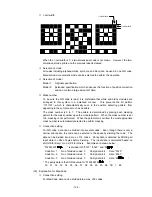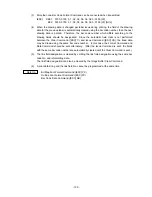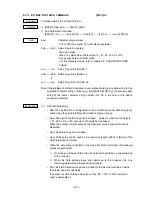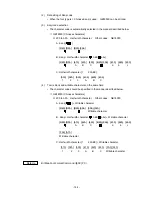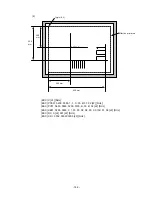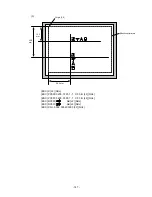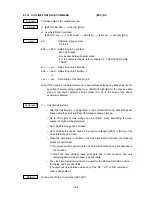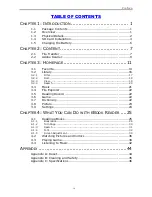
- 136 -
e
Writing binary data on RFID tags
When writing binary data on RFID tags, the data is specified by attaching a ‘>’. Or,
the data is converted to binary format when “conversion to binary” is designated for
the data type, and converted to hexadecimal format when “conversion to
hexadecimal” is designated for the data type. In the case of binary format, only ‘0’
and ‘1’ are used. In the case of hexadecimal format, ‘0’ to ‘F’ are used.
(Example) To specify “00H01H02H”
No
conversion:
>@>A>B
Conversion to binary:
000000000000000100000010
Conversion to hexadecimal:
000102
For details, refer to Chapter 13 BAR CODE TABLE.
f
On-the-fly issue
When “On-the-fly issue” is enabled for RFID write, a data write time depends on the
start point, the end point, and the print speed. If that time is shorter than the time
required to write data onto an RFID tag (300 msec.), the printer will not perform the
on-the-fly issue. When a write error occurs during the on-the-fly issue, the printer will
feed the paper backward and print the void pattern on it. When the printer has no
ribbon saving module, the RFID tag paper may be jammed at the print head during a
reverse feed. Even if the printer includes a ribbon saving module, care must be
taken not to cause a paper jam during strip issue.
Success rate of data write onto RFID tags is high when the print speed is as slow as 3
inches/sec. Even if the on-the-fly issue is enabled, it may take much time to issue
RFID tag paper because the printer will feed the paper backward when an error
occurs. Therefore, the total throughput could be higher when the print condition is
set so that the on-the-fly issue is not performed, RFID data is written prior to printing
and print speed is 10 inches/sec.
g
U-Code V1.19 and EPC format
When U-Code V1.19 or EPC format is designated, data will be written onto an RFID
tag in the format of its own.
Data is all specified with numbers, and no partitions are inserted between the fields.
When U-Code V1.19 and EPC format are designated and both designations are
incorrect, U-Code V1.19 takes precedence over the EPC format.
When U-Code V1.19 or EPC format is designated and the number of input digits of
print data string is different from the size of the data to be formatted for the designated
format, only the input data of designated size is formatted.
When a format is designated and data other than the one supported by the format,
which has designated data string to be printed, is designated, a variable value is
written.
h
Data type
When “conversion to binary” or “conversion to hexadecimal” is designated for the data
type and the number of digits of print data string is less than that for the data type
designated, the remaining digits are filled with “0”, then an RFID write is performed.
This also applies when a link field is designated. Each field must designate 1-byte
data. If data of less than 1 byte is designated, shortfall of data must be filled with “0”
and an RFID write is performed.
Summary of Contents for B-SX4T Series
Page 89: ... 85 F Price font 2 POP font G Price font 3 POP font H DUTCH801 Bold Times Roman Proportional ...
Page 325: ... 321 2 GB18030 code tables TBD ...
Page 326: ... 322 TBD ...
Page 327: ... 323 TBD ...
Page 328: ... 324 TBD ...
Page 329: ... 325 12 9 TrueType FONT 1 PC 850 2 PC 8 ...
Page 330: ... 326 3 PC 852 4 PC 857 ...
Page 331: ... 327 5 PC 851 6 PC 855 ...
Page 332: ... 328 7 PC 1250 8 PC 1251 ...
Page 333: ... 329 9 PC 1252 10 PC 1253 ...
Page 334: ... 330 11 PC 1254 12 PC 1257 ...













